In 2016 I took a cue from commercial tomato growers and started to stake my tomatoes with a string trellis. I was immediately won over by how cheap, easy and EFFECTIVE this method is for supporting a tomato plant.
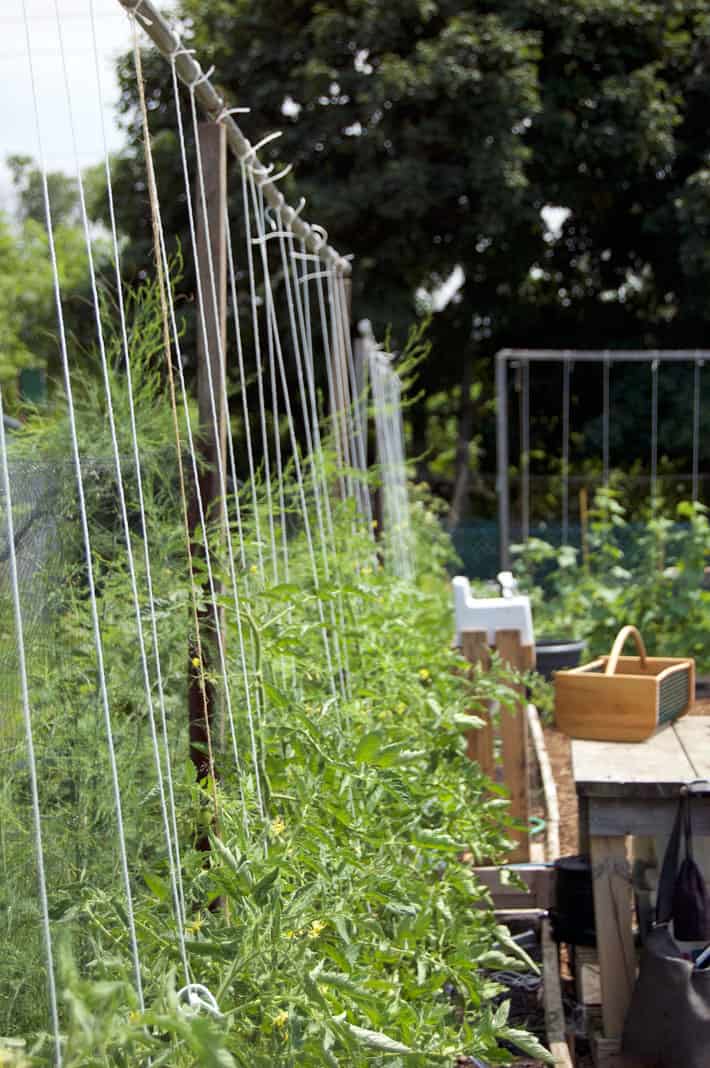
There has to be a better way. There's always a better way. I say that little mantra with pretty much everything I do including growing tomatoes.
I've done cages, stakes, espaliering and the Florida Weave (which works well but still results in a big MESS of tomato plants.)
By the way, the post that talks about how to execute a Florida Weave is actually a post on how to identify and pinch off tomato suckers, so if you don't know how to do that read the post.
My search for the perfect way to support tomatoes ended when I discovered and tried the string method. It didn't even have a name back then. I called it string training.
Now it's referred to as a string trellis.
Table of Contents
QUICK GUIDE
- Create a support structure.
- Tie a string to the top of the structure.
- Pin the string to the ground with a garden staple.
- Plant tomato and wind the stem up the string.
- Continue to wind as the tomato gets taller.
That's it. You can leave the structure and strings in place year after year so you only need to do this once.
I can hear you now.
WHAT ABOUT CROP ROTATION???
For the most part I *do not* rotate my crops because I don't believe in it for a home garden. As long as you fertilize/add compost to your soil every year there will be no soil depletion. And moving your crops 20 feet to the left or right isn't going to confuse or deter any of the pests/disease you have.
How-to Video
String training is a method that up until recently was normally only seen in commercial greenhouses or the back fields of very astute hippie homesteaders.
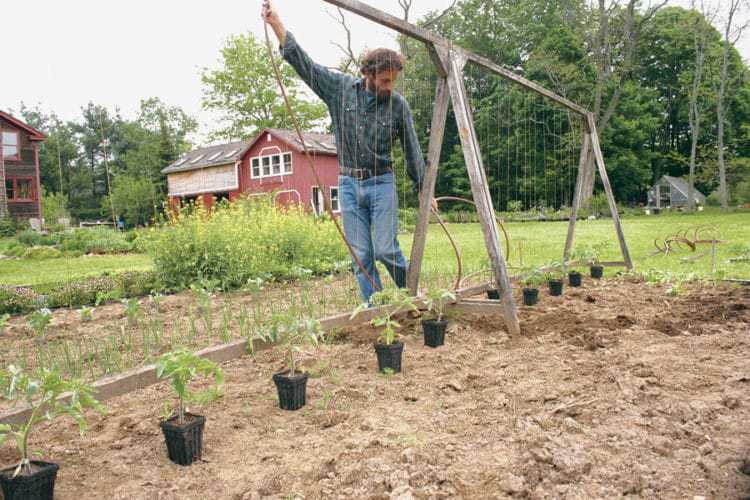
I don't know this guy. This guy is just stringing up his tomatoes. Never met him. Good photo though.
Not only can you use this method for tomatoes, but you can use it for anything that has a stem you can wind upwards.
USE A STRING TRELLIS FOR GROWING CUCUMBERS
Here we go.
How to String Trellis Tomatoes
- Hammer T-posts into the ground 8' apart (or less). For added height, screw an 8' 2x2 into the side of each T-post. Add support across the top.
Screwing another 2x2 into the tops of your posts works well for a support bar, as does an old curtain rod. You just need something sturdy to hang a string from.
TIP: Before screwing your 2x2s into the T-Posts, drill a 3" deep hole into the top of the 2x2s. Wind a coat-hanger-type wire around your rod a couple of times making sure to leave 3" of the ends straight. Slip the looped wire off the rod and stick it into the top of the 2x2. Now you'll be able to slip the rods through the wires to hold them in place. You can see the visual demonstration of this in the video.
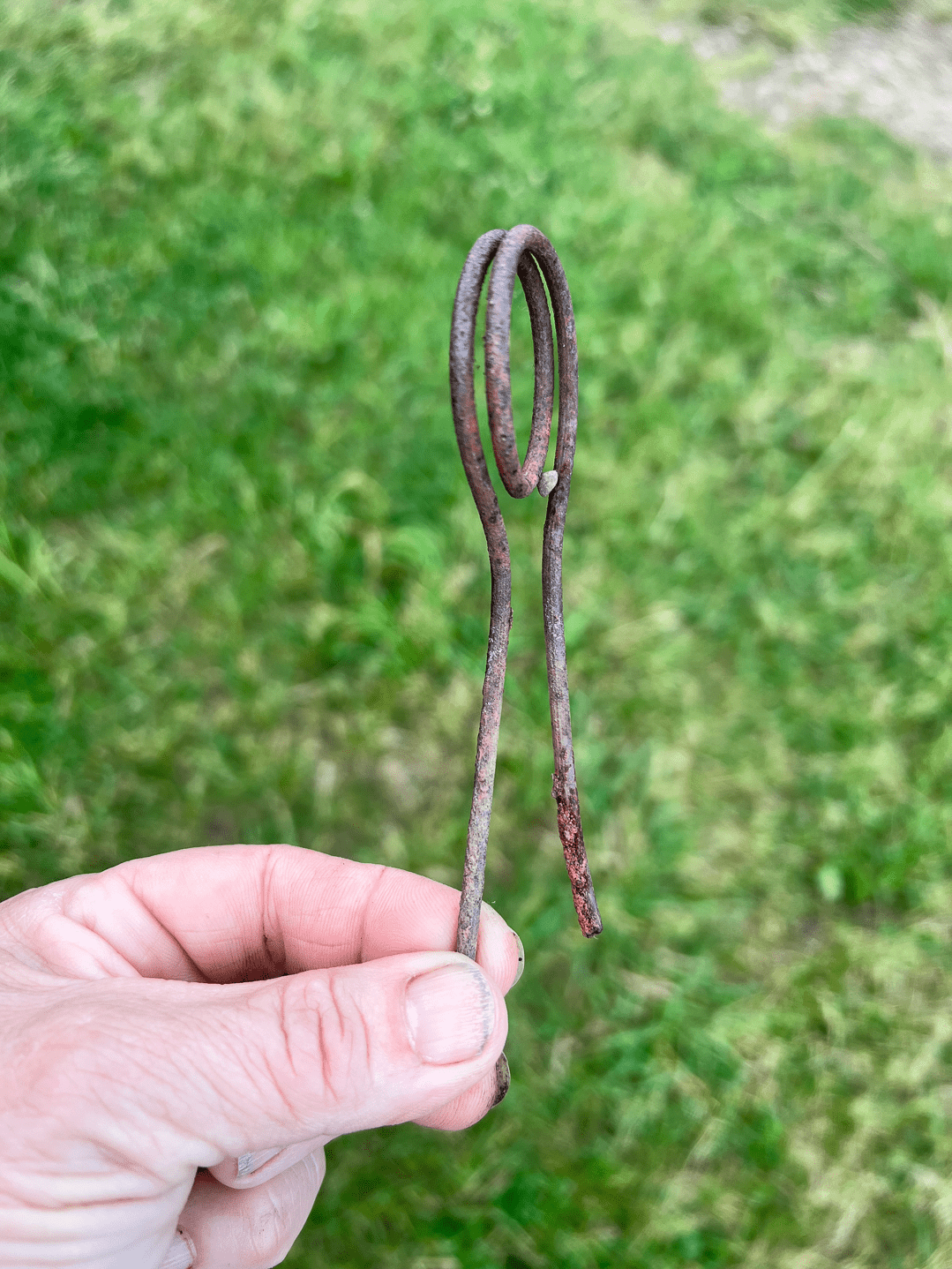
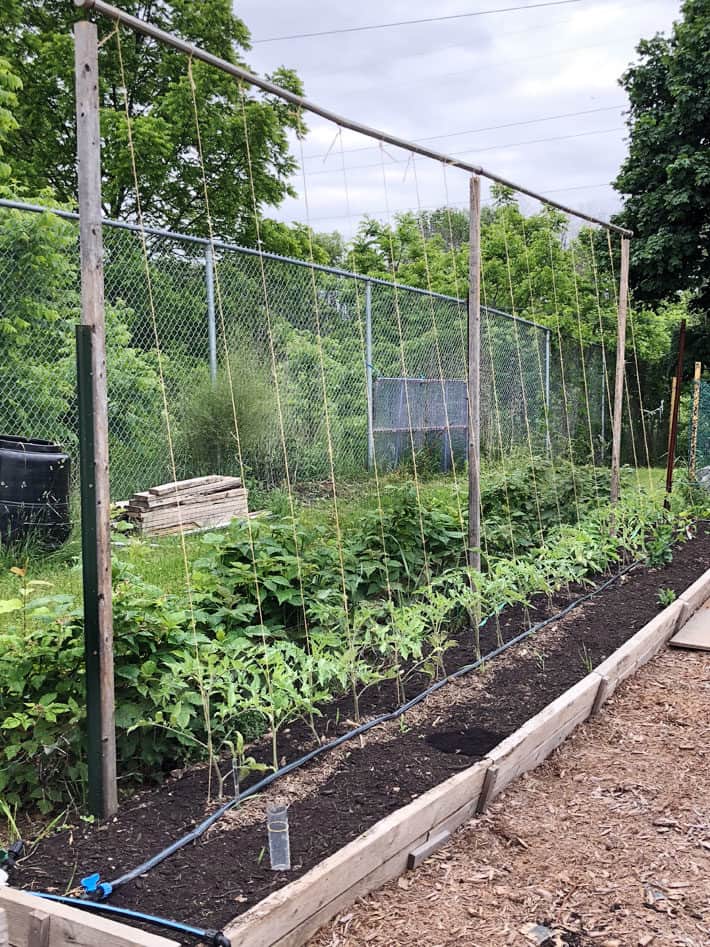
Would you like to save this stuff?
- Tie a thick cotton string every 12"- 18" so it hangs down towards the soil.
- Secure the string to the soil using a garden staple aka landscape staple.
- Remove the lower leaves to help prevent blight and any suckers that have formed. You can read more about how to identify suckers in this post here.
- Plant the tomatoes in front of the string. Plant them quite deep (up to the new first leaf on the plant).
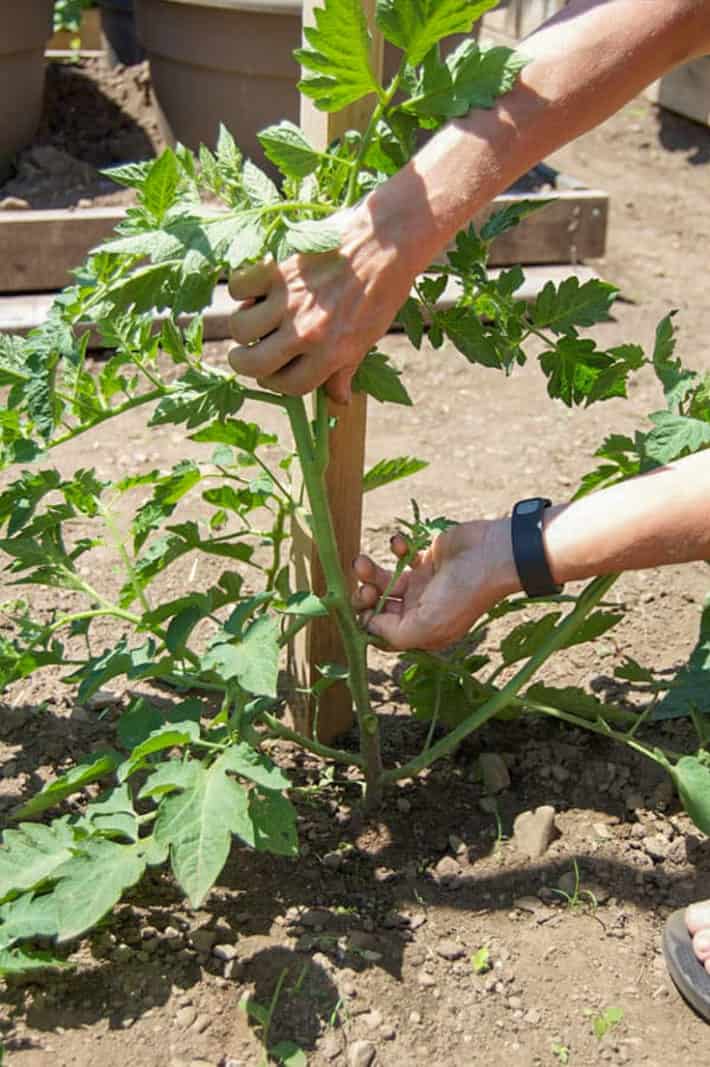
Removing a sucker. The shoot that grows between the main stem and leafy branch of tomatoes.
- Twirl your plants around the string once your tomato is around 12" high and is getting its first set of flowers.
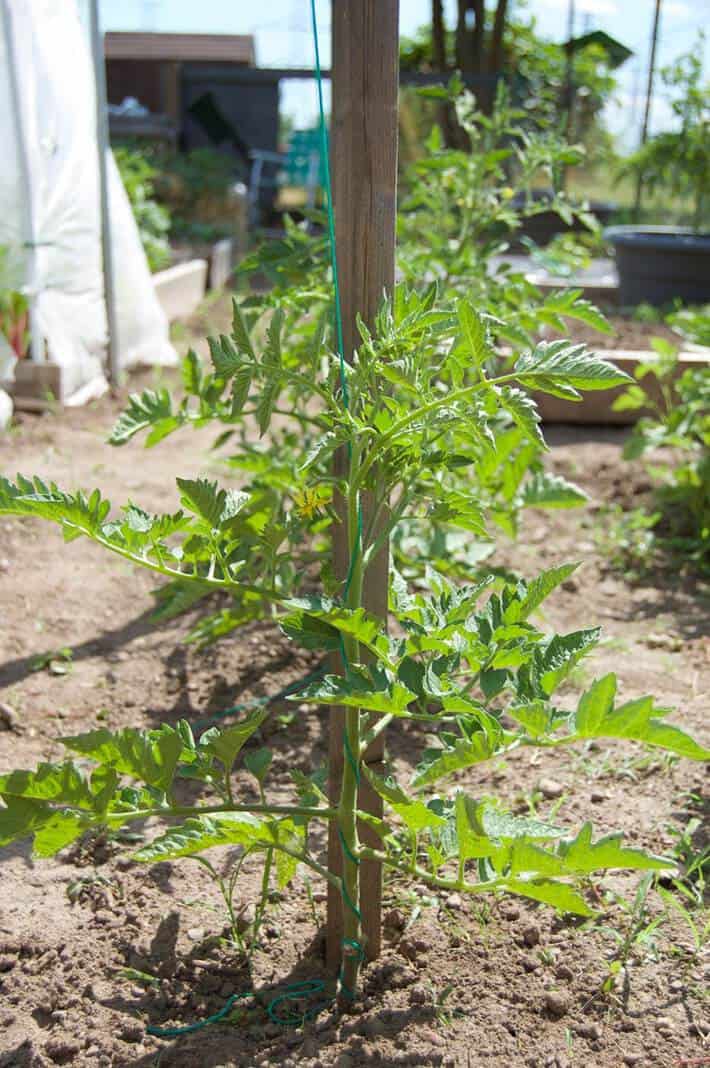
6. Continue to remove suckers and twirl once a week until the end of summer.
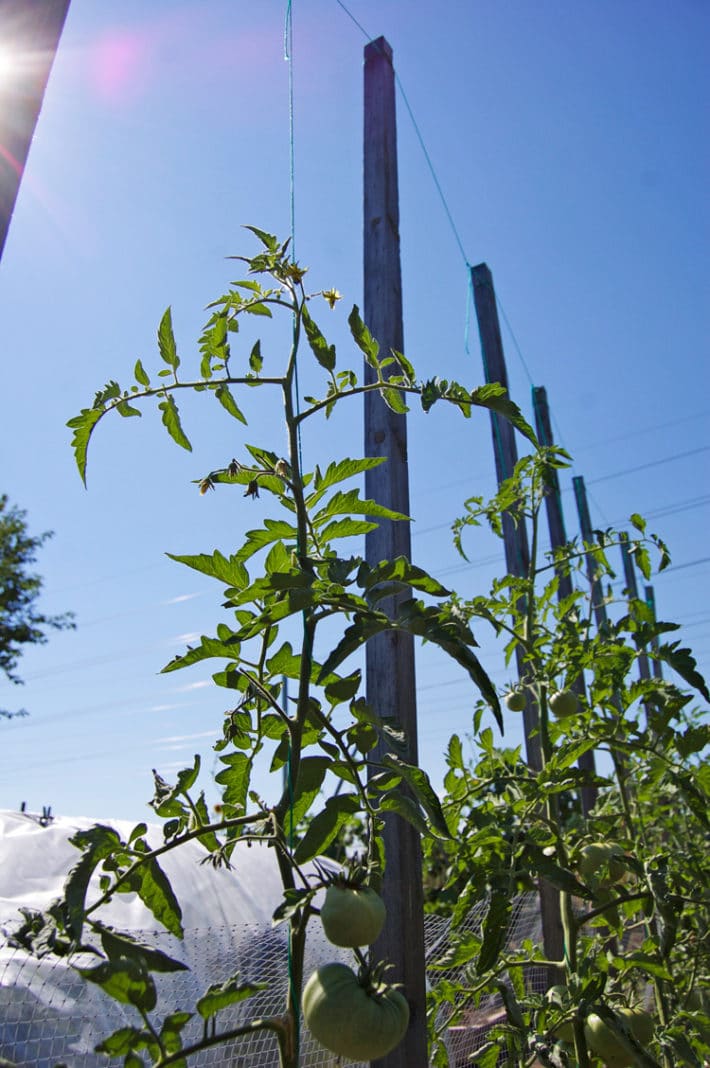
This shows the very first time I tried the method. I only had polyester string so that's what I used. It worked but disintegrated after only one season plus the thin string cut into the tomato stems. This can cause wounds for disease to enter.

The first year I tried this method, I worked with what I had, which was stakes that were already planted in the ground every 18". I just ran a string across the top of them all and hung my string down from that.
Pruning
For a string trellis to be effective you have to keep your tomatoes to 1 or 2 leaders. This is known as the French Method.
- A tomato grows with 1 stem - to begin with. Then as it grows the tomato will create other "leaders". Leaders are the suckers that grow between the main stem of the tomato and a leaf.
- If the sucker/leader is allowed to grow it creates a whole new strong stem for the tomato.
- String trained tomatoes can have 1 leader (the main stem) or 2 leaders (the main stem, plus letting 1 sucker grow into another leader).
- To grow 2 leaders, allow the first sucker that develops on your tomato plant to grow. It will become another stem.
- Each stem will need their own string to climb up with a minimum of 12" between each string.
- Using 2 leaders instead of one will produce more tomatoes but they'll be smaller.

The French Pruning Method.
No suckers, no extra leaders. Only one stem with leaves coming off of it. (except now I see a sucker to the top right of the plant, lol) Oops.
Tomato varieties that work best
Heirloom tomatoes work best with string training because they get TALL. Those are the types of tomatoes you want to grow up a string.
Heirloom tomatoes are known as "indeterminate" which means their height is not predetermined. They will keep getting taller and taller until the end of the season when they die. Indeterminate tomatoes often get to be 10' high.
There are also some hybrid tomatoes that are indeterminate, but for the most part hybrid varieties are "determinate" - meaning their height is predetermined and they won't get any taller than their predetermined height - usually about 5'.
Why String Training is Better Than Staking or Caging.
- Strings can be left up from season to season.
- You can fit more tomato plants into a smaller space.
- Plants can grow as high as 8' or more.
- Keeping plants at one leader gives much better air circulation around the plants which helps keep them disease free.
- String training can also be applied to growing beans or cucumbers
Wanna see how the string method worked with a single tomato plant flat against a fence? It would work flat against a house too. The string method on a single tomato plant makes it look similar to an apple espalier.
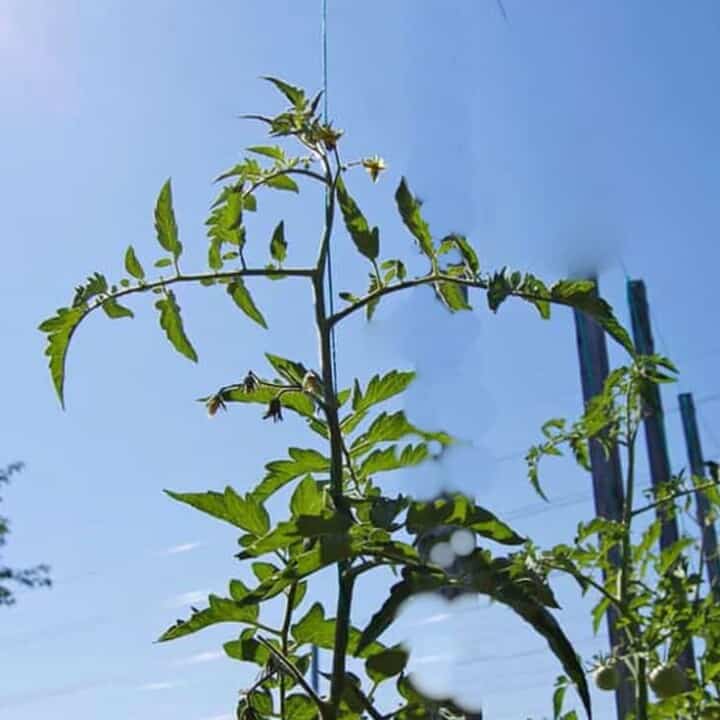
String Trellis - Printable Instructions
Whether you're new to gardening or not you're probably constantly searching for the best way to stake tomatoes. THIS is it.
Materials
- Heavy string
- 3, 8' stakes (2x2s work well)
- tomato plants
Instructions
- Run a wire, pipe or stake between two 8′ high stakes. You can also use string in a pinch.*
- Tie a string every 12″- 18″ so it hangs down towards the soil. Plant your tomatoes at every string so they are also 12″-18″ apart.
- Secure the string to the soil at the base of your tomato with a garden pin by winding the string around the pin and shoving it in the soil. You can also wrap the string several time around the base of the tomato plant to secure it. (I use pins now, I used to just wind it around the base of the plant)
- Remove any suckers that have formed. You can read more about how to identify suckers in this post here.
- Twirl your plants around the string once your tomato is around 12″ high and is getting its first set of flowers.
- Continue to remove suckers and twirl once a week until the end of summer.
Notes
- You can use any string but synthetic string that doesn't stretch is best. It will also last for years.
- Biodegradable string like jute or twine can also be used as long as it's thick enough not to degrade and fall apart during the growing season. It should be replaced every year.
- Never prune off more than 25% of foliage at one time.
- You can allow your tomato plant to have either one or two leaders.
- *to give extra support to your stakes hammer in a metal t post right next to each stake in the ground, then screw them together. Once your stake rots at soil level in a couple of years, it'll stay in place looking nice because of the t post.
Cotton clothesline works the best and lasts for years. ¼u0022, 7/32u0022 or 3/16u0022 are the best options. It will last for years. Thinner string or rope will degrade too quickly and break.
Nope. Garden staples do work the best but you can also just pull the string tight to the ground and wind the tomato stem around it.
By the end of the summer you'll have straight, tall tomatoes which get a lot of air circulation and a lot of sun. They'll be bald at the bottom and producing healthy tomatoes at the top.
Hypothetically of course.
Because this is gardening and all hell could break loose at any moment. A wild band of twirling goats or screaming aphids could come barreling through your garden destroying everything in its wake.
You just don't know.
→Follow me on Instagram where I often make a fool of myself←
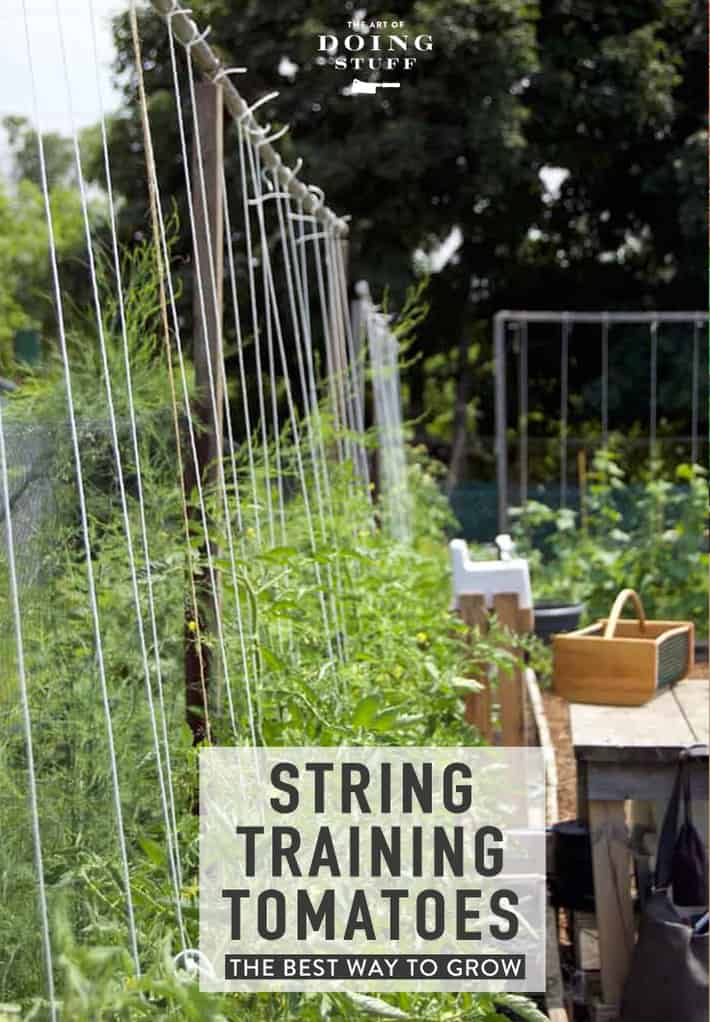

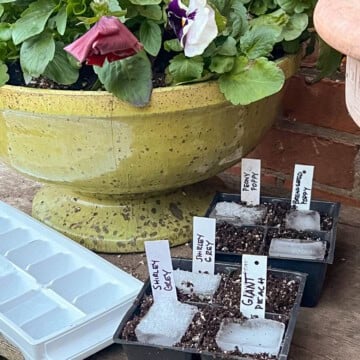
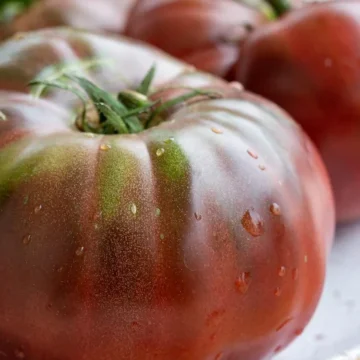

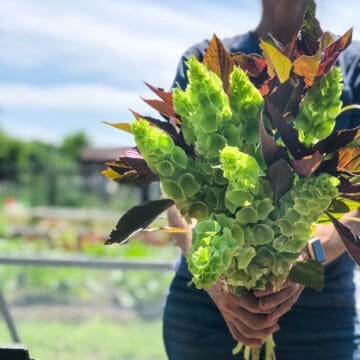
Garth Wunsch
I've also done this for years with tomatoes, cucumbers and pole beans. Works wonders and great space saver. My A-frame is made of Maple saplings that I salvage from the bush and reuse many years. Your friends installation is very neat and well built, but he will have a lot of work moving it next season... if he wants to help avoid disease by rotating his crop. I mulch heavily with straw and plant green onions and lettuce along the free understory area. Mulching is amazing - I can weed my 1200 square foot garden in under five minutes once a week.
Katie C.
I've seen this method done on TV by huge nurseries, but I didn't realize actual people did it!
This is my first year with a vegetable garden and there's just so much information! I want to try everything.
Gail Blain Peterson
I do the Florida weave method. In NW Kansas is it HOT and if we remove all the excessive foliage the tomatoes will scald, sunburn, etc -- actually sometimes they do even with the excessive foliage. So messy looking tomato rows are my reality.
Eileen
Goats, screaming aphids...or you can discover the world's cutest little bunny in your yard...and then discover that all your bean and okra seedlings are nothing but tiny stalks gasping their last. And it's way too late to do this with my sorry looking lot of tomatoes this year. Which is probably why said bunny has left them alone? Yesterday I had an attack of "mean" and sprinkled cayenne all around the remaining seedlings. (and boy, do I feel guilty)
Victoria
I do a version of this with my red and yellow jelly bean tomatoes. I've made frames by bending electrical conduit into 4 foot wide 8 foot tall trellises. 2 pieces of 10 foot conduit bent at the 2 foot mark, then join the short ends with a little joint brackets. Jam the long ends into the ground and string six pieces of string hanging down. Yes, I have to use a step ladder to set it up!
I plant 2 plants under the trellis and prune them so I have 3 strong branches from each plant, training each up a string. Every year they grow up and over the trellis! It is sooo easy to find the tasty little jelly beans because the plant is flattened out.
New string each year but the frames can be popped out and stored in the garage. Though my dad has been known to leave his up all winter and string up Christmas lights...
Karen
Ha! A christmas light tomato trellis. Love it. karen!
Mel
The string tie method is how my Bulgarian grandfather grew tomatoes in his glasshouses, commercially- so with great success!
As for the arm skin thing- here in Oz we call those bat wings, tuckshop arms, bingo wings or if you've seen the show Kath 'n' Kim 'fadoobadahs'... :) Mine are awesome when writing on the blackboard at school!!
jainegayer
I understand the french method has way more swagger but that guy in the blue jeans seems to have some swagger going on. Are you sure you don't know him? What's this blog about, stringing tomatoes? I need coffee.
Ann
you made the comment that you can string tie indeterminates but not hybrids. But I think that you might have to replace hybrid with determinate, which is the lower growing, everything gets ripe at once kind of tomato. Hybrids can be either determinate or indeterminate.
My tomatoes are looking wonderful right now. But the stink bugs keep bothering the fruit so we have to pick it the second there is any color at all to them and bring them in to finish ripening. So of course, right now I have no kitchen counter tops available to do anything with. But it is very very colorful!
Karen
Yes that's true. I always use hybrid and determinate interchangeably all the timeeven though they're not the same, lol. In *most* but definitely not all cases hybrids are usually determinate. ~ karen!
Thom Spengler
Karen, that’s simply not true. Most of the big seed companies (e.g. Burpees) promote F1 hybrids, because those hybrid’s seeds will not breed true to the parent plant. So you buy their seeds every year. Look at a Burpee catalog; the great majority are hybrids. The words determinate & indeterminate are the proper descriptors.
Of course that’s a minor flaw in a wonderful article... would appreciate more pix of cordoned tomatoes in August, after a bit of production. Thanks.
Carswell
When my ex and I first bought the house I now own we had a big veggie garden in the back. After doing a bunch of reading, looking at beautiful pictures of potagers and whatnot - and because I love just about any kind of garden structure and trellis - we built a support system like the one in the first pice and grew a truckload of tomatoes.
That system works extremely well, keeps the tomatoes amazingly neat and accessible, ensures the ripening tomatoes get lots of sun and is, as an added bonus, inexpensive.
Rita
This is the only way I've ever grown tomatoes. I didn't even realise other ways existed. Maybe that's just my Englishness (is that even a word?) showing....
It can still get messy though. Believe me.... ?
joanne
Rita, this is what I've always done as well. I didn't know there was a name for it, just knew that it kept the garden tidier (and that way, if the nasty tomato hornworm comes back, you can actually see where he is causing damage, and then hopefully find the gross green giant icky bug and smash it.
Courtney
Do you propagate your suckers into new plants ? I toss mine in an old maple syrup bottle in my kitchen window for a week then plant em out succession style.
Karen
Nooooooo, lol. I don't have any need or space for more tomatoes, lol. But I have propagated suckers of cherry tomatoes later in the year to grow on a windowsill indoors throughout the winter. Works great. :) ~ karen!
Bambi Mayer
I don't have a garden yet and don't see one in the near future but loved the post. One question....will you please, please, please post a good tutorial on how to do the bat wing underarm self-surgery when you figure it out. I have the utmost confidence in you, so I know you will perfect the technique!
Dagmar
Hahaha
Lynn
I am also looking forward to your garden . This year we only planted a few zucchini , yellow and green beans. As we knew the yard was going to get revamped . In short we have built a new shed, a green house, redid the main raised garden beds , shrunk a deck and are in the process of screening in the carport. That all said I miss our garden an I am on pins an needles as I await news of yours .
Karen
Because I took on TWO gardens this year (not including my front yard garden) they're both a bit of a mess while I get things figured out. By next year it should be better. ~ karen!
Cred
I did the string method this year, too. I don't have near as many tomatoes but I had to build a bamboo A-frame with a horizontal pole spanning them (like a swing set) because I can't seem to drive a stake deep enough before hitting a rock. I tie the string to the plant base and run to the top horizontal pole. Seems to be working quite well.
Alita
I use this method for cordons too. I put the loose end of the string under the rootball when I plant it and, as the plant's roots grow, the string is secured.
Kathleen
Is leaf curl a bad thing? Never heard of it before... Google here I come! Again! I seem to do a whole lot of research after reading your posts. :) filling up the gaps in my 'useless but interesting' memory banks!
Barbie
TOTALLY doing this next year. Have cut my garden by 3/4 this year. To much to do and even that keeps me busy. Tomatoes are going crazy, but like you said all hell could break loose at any moment and tomato beetles are threatening to destroy everything! Drives me crazy and I'm discouraged.
Gayle''
Julie, crushed egg shells can help reduce blossom end rot. I tried it one year and it worked pretty well. It's all that calcium in the shells. Just scatter them around the base of the plants.
JulieD
Thanks Gayle. Sounds like a good thing to try.
Marna
I will be following you to see how it works out. Well not that I would do it, just too much for me
these days, but I am interested. My dad tried it all years ago, he had the best luck with concrete wire and making a large cage of it with 1x4s cut in half long way . I swear he had the best tomatoes, sweet and huge, even the ones that were suppose to be smaller. I think it was the chicken poop he added! LOL! Good luck!
Marna
Forgot to mention the chicken poop was composted which was probably what really did it, lots of composting!
JulieD
yay! I do my tomatoes that way too! If you tie a slip knot at the top you can loosen the string when you're winding them, to make it easier, then tighten it right up after. Last year i still lost a lot of my tomatoes to blossom end rot though, due to a failed experiment. Works great when it's done the right way though.
Karen
I have to say I'm a convert JulieD. I love this method and I'm already seeing more tomatoes per plant than I ever do on the heirlooms. My great potato in straw experiment is not going as well I don't think, lol. I'll be doing a garden update soon and talk all about it. ~ karen!
JulieD
Looking forward to it!
E.J. Humphrey
JULIED...Blossom End Rot is caused by inconsistent watering, not by lack of calcium.
http://www.gardenmyths.com/blossom-end-rot/
Darwin
I disagree. I tried following the consistent watering technique but still could not get rid of blossom end rot. Then I tried adding ground up egg shells to the planting hole and I haven't had end rot since. I've continued to water the way I always have. I'm 100% sold on egg shells.
Donna
I use egg shells as well. II also layer a handful of Epsom salt in the hole cover with dirt and then plant the tomatoes in the hole. The Epsom salt is an old farmers trick. Plenty of tomatoes on the vine.
Lynn
I had blossom rot this year on two of my plants. After ONE application of a lime solution to lower the pH of the soil it went away. I’m a convert!
Jim Herlihy
Lime or egg shells do not lower the pH, they raise it
Vera
I don’t understand how to twirl the plant that is rooted in the ground, won’t that disturb it?